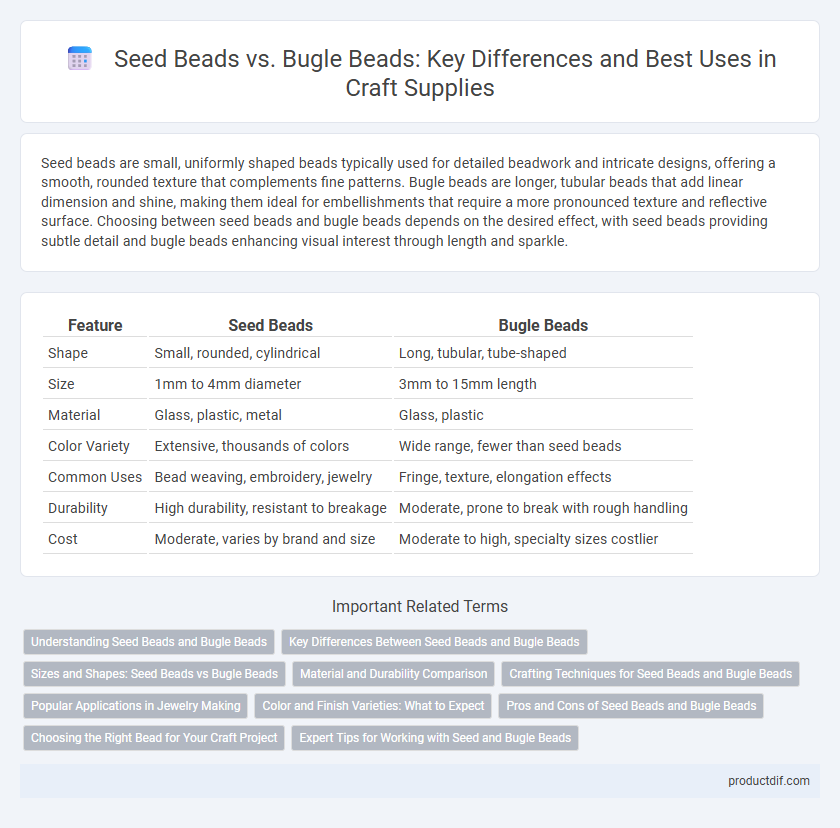Seed beads are small, uniformly shaped beads typically used for detailed beadwork and intricate designs, offering a smooth, rounded texture that complements fine patterns. Bugle beads are longer, tubular beads that add linear dimension and shine, making them ideal for embellishments that require a more pronounced texture and reflective surface. Choosing between seed beads and bugle beads depends on the desired effect, with seed beads providing subtle detail and bugle beads enhancing visual interest through length and sparkle.
Table of Comparison
| Feature | Seed Beads | Bugle Beads |
|---|---|---|
| Shape | Small, rounded, cylindrical | Long, tubular, tube-shaped |
| Size | 1mm to 4mm diameter | 3mm to 15mm length |
| Material | Glass, plastic, metal | Glass, plastic |
| Color Variety | Extensive, thousands of colors | Wide range, fewer than seed beads |
| Common Uses | Bead weaving, embroidery, jewelry | Fringe, texture, elongation effects |
| Durability | High durability, resistant to breakage | Moderate, prone to break with rough handling |
| Cost | Moderate, varies by brand and size | Moderate to high, specialty sizes costlier |
Understanding Seed Beads and Bugle Beads
Seed beads are small, uniformly shaped glass beads commonly used in intricate beadwork and embroidery for detailed patterns, whereas bugle beads are elongated, tubular beads that add texture and dimension to designs. Seed beads come in various sizes, primarily measured in aughts (e.g., 11/0, 15/0), offering versatility in color and finish, while bugle beads range in length and thickness, providing linear accents in jewelry and textile crafts. Understanding the distinct shapes, sizes, and applications of seed beads versus bugle beads enables crafters to enhance the complexity and visual appeal of their projects.
Key Differences Between Seed Beads and Bugle Beads
Seed beads are small, rounded beads known for their uniform size and smooth finish, commonly used in intricate beadwork and embroidery. Bugle beads, on the other hand, are tubular and elongated, offering a distinct linear texture ideal for adding dimension and sparkle to designs. The key differences lie in their shapes, sizes, and applications: seed beads provide a consistent base for detailed patterns, while bugle beads contribute structural variety and visual interest.
Sizes and Shapes: Seed Beads vs Bugle Beads
Seed beads are small, rounded beads typically ranging from sizes 15/0 to 6/0, offering uniformity in shape and ideal for intricate patterns and detailed beadwork. Bugle beads are elongated, tubular beads available in various lengths, generally measured in millimeters, providing a linear, textured effect perfect for adding dimension and shimmer. The contrasting shapes and sizes between seed beads and bugle beads enable diverse design possibilities in crafting projects.
Material and Durability Comparison
Seed beads are typically made from glass or plastic, offering a smooth, rounded shape that enhances their durability for intricate beadwork projects. Bugle beads, usually crafted from glass or metal, have a tubular form that provides rigidity but can be more prone to chipping or breaking under stress. Comparing materials, seed beads generally exhibit higher resilience for everyday crafting, while bugle beads offer a distinct structural strength ideal for specific design accents.
Crafting Techniques for Seed Beads and Bugle Beads
Seed beads, known for their small, round shape, are ideal for intricate bead weaving, embroidery, and peyote stitch techniques, offering precise detailing in designs. Bugle beads, which are elongated and cylindrical, excel in adding texture and linear accents through techniques like fringe beading, loom work, and embellishing with sewn patterns. Combining seed beads with bugle beads enhances dimensionality and complexity in crafting projects, often used in jewelry making and decorative textiles.
Popular Applications in Jewelry Making
Seed beads, known for their small, uniformly round shape, are predominantly used in intricate bead weaving, embroidery, and loom work for creating detailed patterns in bracelets and necklaces. Bugle beads, characterized by their elongated cylindrical form, add texture and dimension to fringe designs, statement earrings, and decorative edging in jewelry pieces. Both types of beads are essential in mixed-media jewelry projects, offering versatility in design and enhancing visual interest.
Color and Finish Varieties: What to Expect
Seed beads offer a vast spectrum of color options ranging from opaque to translucent shades, with finishes including matte, metallic, and iridescent that enhance intricate designs. Bugle beads typically come in slimmer, elongated shapes with fewer color variations but feature unique finishes like metallic, matte, and sometimes gloss that add dimension to beadwork. Both seed and bugle beads provide diverse textures and finishes, allowing crafters to experiment with light reflection and color blending for dynamic jewelry and decorative projects.
Pros and Cons of Seed Beads and Bugle Beads
Seed beads offer uniform shape and vibrant colors, making them ideal for intricate beadwork and detailed patterns, but their small size can slow down larger projects. Bugle beads provide a sleek, elongated form that adds texture and dimension to designs, yet they may require complementary beads for stability in complex pieces. Choosing between seed and bugle beads depends on the desired visual effect, project scale, and ease of handling.
Choosing the Right Bead for Your Craft Project
Seed beads offer uniform shapes and sizes, ideal for intricate bead weaving and detailed patterns. Bugle beads provide elongated, tubular forms perfect for adding texture and dimension through fringe or embroidery. Selecting between seed and bugle beads depends on the desired craft effect, with seed beads enhancing precision and bugle beads contributing dynamic surface interest.
Expert Tips for Working with Seed and Bugle Beads
Seed beads offer uniform size and shape, ideal for intricate bead weaving and detailed patterns, while bugle beads provide elongated shapes that add texture and dimension to designs. Expert tips include using a finer needle handle for seed beads to navigate their small holes efficiently, and incorporating bugle beads strategically to enhance depth without overpowering the project. Sorting beads by size and color beforehand streamlines the crafting process and ensures consistent results in both seed and bugle bead projects.
Seed beads vs Bugle beads Infographic

 productdif.com
productdif.com